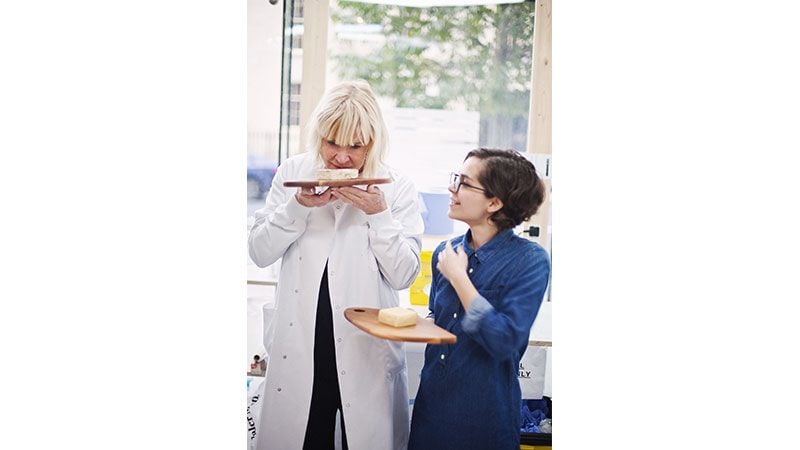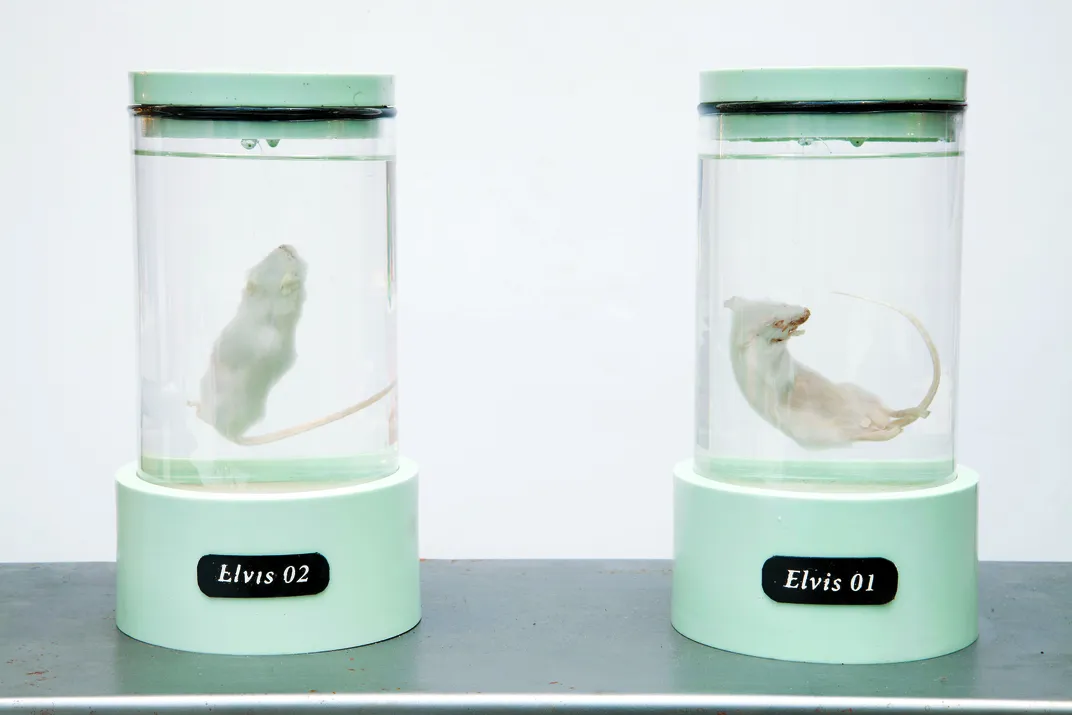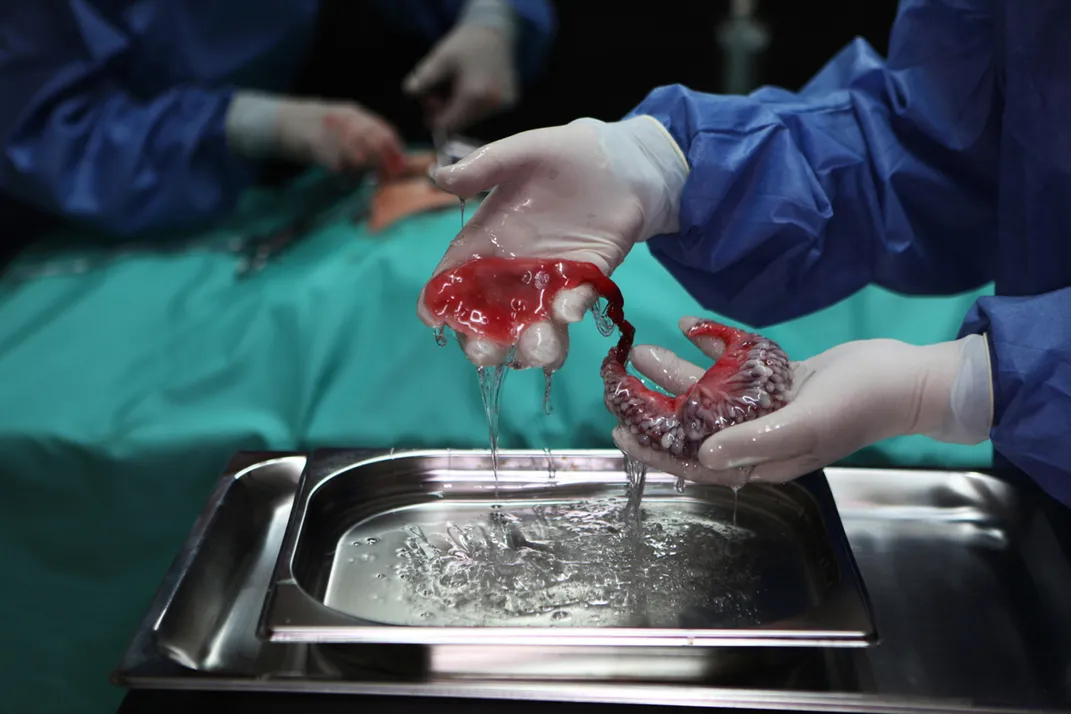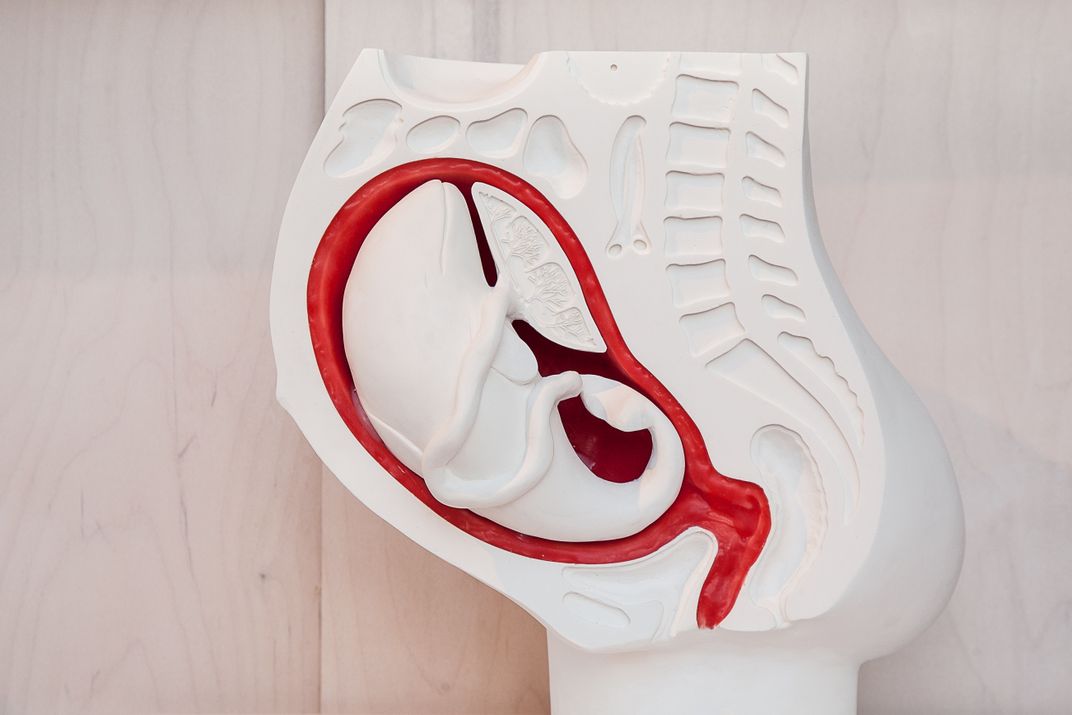Cheese Made From Bacteria Between Your Toes and Other Bizarre Bio Art
With groundbreaking (and controversial) projects, artists are starting a conversation about the future of synthetic biology
/https://tf-cmsv2-smithsonianmag-media.s3.amazonaws.com/filer/74/f9/74f94e74-abe8-46d6-87ce-39933dcef5d2/selfmade_as_part_of_grow_your_own_at_science_gallery_image_2_by_alexandra_daisy_ginsberg.jpg)
If a cheesemonger were to offer you brie or a pungent stilton, and just as you reach for it, share a juicy detail—that she culled bacteria from her own armpit to make it—what would you do? Would you turn your nose up and politely decline?
Or, what if a pet shop advertised transgenic mice, containing genes from celebrities? Would you be frightened, or more enticed to take one home?
“Grow Your Own…Life After Nature,” an exhibition recently at Trinity College Dublin’s Science Gallery, features 20 works—all art projects as much as science experiments—that raise these questions and others just as bizarre.
The show’s curatorial team of artists, designers, scientists and bio-hackers made an open call in the spring 2013 for projects that “move the public conversation about synthetic biology forward.” From the submissions, they selected visionary works that together show how a future where we can engineer life to fit our own needs might look and feel like.
“'Grow Your Own’ is all about what happens when you are able to design living organisms. Imagine you are actually able to take some sort of living creature and design it into a product. What would that look like?” says Michael John Gorman, director of Trinity College Dublin’s Science Gallery in a promotional video.

In Selfmade, microbiologist Christina Agapakis and scent artist Sissel Tolaas collected bacteria from the mouths and toes (“where you get a lot of diversity,” Agapakis has said) of willing participants, including food writer Michael Pollan. They cultivated that bacteria and yeast in petri dishes and eventually combined them with milk to create farmhouse cheddar and whey cream cheese. Because the end products—actual hunks of cheese on display in the exhibition—are representative of each bacteria donor’s unique microbiome, the creators call them “cheese portraits.”
“We all know that cheese and body smells are very much associated,” says Tolaas, in a video produced in conjunction with the exhibition. Agapakis chimes in: “The bacteria that you find in between the toes is actually very similar to the bacteria that makes cheese smell like toes.”

Artist Koby Barhard’s All That I Am, also part of the exhibition, begs viewers to think more deeply about genetics. He bought hairs of Elvis Presley’s on eBay, had a lab sequence the DNA and another one actually take genetic material from the hair and put it into mice. For the show, the mice are preserved in jars labelled "Elvis 01" and "Elvis 02." “I was trying to see how people would actually perceive it [the Elvis mouse],” explains Barhard in a video.
The pieces are playful, and yet they raise very serious questions. “Do we really want to create this?” asks Gorman. “Just because we can, does it mean we should?”
The projects are controversial at their very core. They force us to think about the many potential applications of synthetic biology and stir up ethical and legal debates. Which applications are we comfortable with and which are too Frankenstein-esque for our liking?

British designer Agatha Haines’ entry, Circumventive Organs, postulates about superhuman organs, that may one day be made with tissue from other animals. Of course, what is on display in the exhibition are realistic-looking sculptures of these organs, not slimy guts grafted together, but the effect is no less visceral. Haines also created a short film that shows what it might be like for surgeons to implant these organs.
Her hypothetical Electrostabilis Cardium is an organ infused with parts from an electric eel that acts as a natural defibrillator; during cardiac arrest, this organ could send an electric current to the heart to get it beating again. The Tremomucosa Expulsum would enlist rattlesnake muscles to keep mucus moving through the respiratory and digestive systems of people with cystic fibrosis.

Even more far-fetched, Japanese artist Ai Hasegawa’s I Wanna Deliver a Dolphin… envisions what it would be like for a woman to actually grow an endangered species in her womb. The installation consists of a cutaway-type medical model of a woman's womb with a developing Maui's dolphin in it and an artistic video staging a woman's water birth of a mechanized dolphin. “Mothering a shark or a dolphin could satisfy the maternal urge, while investing in the food supply,” Hasegawa told The Guardian.
There is a growing “bio-hacker” culture, particularly as lab techniques and equipment become cheaper, easier and more accessible. DIYbio.org lists 20 do-it-yourself biolabs in North America, 16 in Europe, two in Asia and two in Australia and New Zealand. These community spaces typically offer instruction for amateur scientists looking to tinker.
Alexandra Daisy Ginsberg, lead curator for “Grow Your Own,” is vocal about art’s role in navigating a future with synthetic biology.
“There is no correct answer to whether transforming biology into a medium for design from the DNA up is a good idea. Synthetic biology, if the technology comes to pass, could enable us to consume more responsibly, if we begin to think about what we want from it now. That said, it also has the potential to not only perpetuate status quo, but make a less equal world as we engineer and privatize the material that we are made of. That a technology is possible is not enough to justify it, we need to examine where the ethical boundaries should lie,” she tells me, in an email exchange. “I think art and design are incredibly useful tools to explore a technology and its potential, identify new questions, and express our fears.”
For more thought-provoking projects featured in "Grow Your Own," visit its website.
/https://tf-cmsv2-smithsonianmag-media.s3.amazonaws.com/accounts/headshot/megan.png)
/https://tf-cmsv2-smithsonianmag-media.s3.amazonaws.com/accounts/headshot/megan.png)